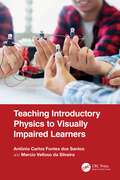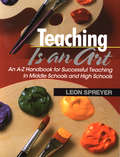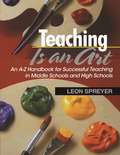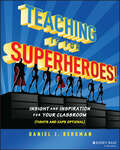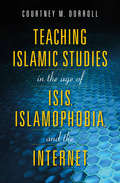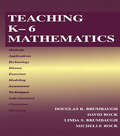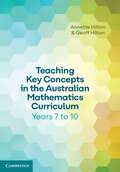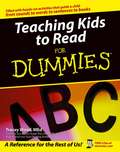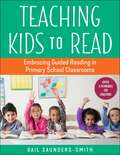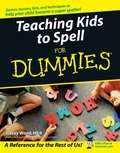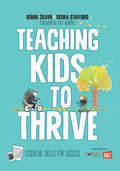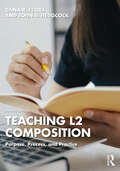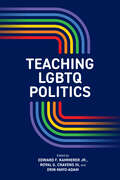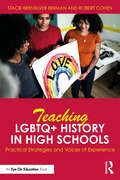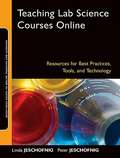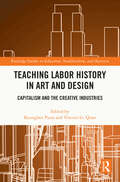- Table View
- List View
Teaching Introductory Physics to Visually Impaired Learners
by Antônio Carlos dos Santos Marcio Velloso da SilveiraFollowing global inclusion policies and initiatives, more students with visual impairments are attending regular education in inclusive schools. Universities also increasingly accept students with visual impairments in the most varied courses, including engineering and physics. However, teachers do not always have experience with teaching this specific audience. Teaching Introductory Physics to Visually Impaired Learners provides a gateway to understanding the difficulties encountered by this audience and provides ways for teachers to embrace this challenge. The concept of inclusion is discussed in light of the historical evolution of the achievements of people with disabilities and the development of reading and writing in Braille, in addition to other more modern tools, such as cell phone applications. The remaining chapters present methodologies for teaching mechanics, waves, electrodynamics, optics, and modern physics in classes where there are one or more students with visual impairments. The main target audience for this book is elementary and higher education physics teachers and researchers. This book is also of great value to anyone, including teachers from other areas and students with visual impairments, who are looking for teaching materials that facilitate learning for people with visual impairments.Key Features: The first book to help readers understand the difficulties of inclusive physics teaching for students with visual impairment. Allows the reader to have a broader view of what visual impairment is, bringing together theoretical tools necessary to value and promote inclusive education. Encourages the reader to reproduce the physics teaching methodology, with low-cost materials, which facilitates its implementation in the classroom.
Teaching Is an Art: An A-Z Handbook for Successful Teaching in Middle Schools and High Schools
by Leon SpreyerThis reader-friendly guide provides teachers with information, games, book recommendations, specific lesson plans, and straightforward advice on 82 essential aspects of teaching.
Teaching Is an Art: An AZ Handbook for Successful Teaching in Middle Schools and High Schools
by Leon SpreyerDrawing upon close to thirty years of teaching experience, Leon Spreyer provides teachers with practical information that is not always taught in teacher education courses. New and veteran teachers alike will find useful advice for managing their work both in and out of the classroom. The book covers eighty-two essential topics, including cooperative learning, managing parents, staff meetings, implementing tests, portfolios, setting rules, and much more.Highlights include:Practical advice on more than eighty subjectsBook suggestions and games for the classroomSuggestions for staying motivated and avoiding burnoutTeaching ability, wisdom, and fervor are not inborn; teachers learn the elements of their art. With that in mind, Spreyer provides information, games, book recommendations, specific lesson plans, and straightforward advice on all aspects of teaching, ranging from Back-to-School Night to power in the classroom, and from homework to substitute teachers. And he does it in a reader-friendly style, with easy-to-follow lists, examples, and suggested resources.
Teaching Is for Superheroes!: Insight and Inspiration for Your Classroom (Tights and Cape Optional)
by Daniel J. BergmanThis isn't your average teaching book. With a fun, comic-book-inspired layout, Teaching Is for Superheroes! skips the information overload and gives you practical action steps for igniting enthusiasm in your K-12 classroom and achieving your professional goals. Now more than ever, teachers are in high demand—yet the threat of burnout still looms large. This book will help you keep the spark alive, engaging you in a deeper examination of education by way of entertaining superhero archetypes and tropes. What’s your teaching origin story? Your secret identity? Your powers, weaknesses, nemeses? The teachers-as-superheroes metaphor provides a rich venue through which you can thoughtfully analyze your purpose and pedagogy. This high quality, eye-catching book offers you an inspirational springboard for practical insight and application in the classroom. You’ll gain ideas for surviving your first year, navigating social media as a teacher, interacting productively with colleagues and parents, using tech in the classroom, prioritizing self-care, harnessing your teacher “superpowers,” and even dressing for teaching success. The school setting may not be as glamorous as the futurist skyscrapers, alien planets, or alternate universes we see in movies and comics, but the adventure is just as exciting—and best of all, it’s real! Gain teaching insights, tips, and advice in an entertaining, superhero-inspired format Identify your teaching superpowers and weaknesses, and learn to lean on others when needed Explore the “universe” of teaching to understand where you fit in and how you can leave your legacy Equip yourself with the gadgets and gizmos you need to sharpen your skills and power up your classroom Current and future K-12 educators—pick up Teaching Is for Superheroes!, put on your cape, and start saving the world, one class at a time.
Teaching Islamic Studies in the Age of ISIS, Islamophobia, and the Internet
by Courtney M. DorrollHow can teachers introduce Islam to students when daily media headlines can prejudice students' perception of the subject? Should Islam be taught differently in secular universities than in colleges with a clear faith-based mission? What are strategies for discussing Islam and violence without perpetuating stereotypes? The contributors of Teaching Islamic Studies in the Age of ISIS, Islamophobia, and the Internet address these challenges head-on and consider approaches to Islamic studies pedagogy, Islamaphobia and violence, and suggestions for how to structure courses. These approaches acknowledge the particular challenges faced when teaching a topic that students might initially fear or distrust. Speaking from their own experience, they include examples of collaborative teaching models, reading and media suggestions, and ideas for group assignments that encourage deeper engagement and broader thinking. The contributors also share personal struggles when confronted with students (including Muslim students) and parents who suspected the courses might have ulterior motives. In an age of stereotypes and misrepresentations of Islam, this book offers a range of means by which teachers can encourage students to thoughtfully engage with the topic of Islam.
Teaching Islamic Studies in the Age of ISIS, Islamophobia, and the Internet (Encounters: Explorations in Folklore and Ethnomusicology)
by William Maynard Hutchins Kecia Ali Todd Green Kimberly Hall Doaa Baumi Manuela Ceballos Nathan S. French Shehnaz Haqqani Benjamin Geer Mouez Khalfaoui Alfons H. Teipen Laila Hussein Moustafa Sabahat F. Adil Phil Dorroll Lyndall Herman&“A much-needed volume and a must read&” for educators addressing a challenging topic in a challenging time (Choice). How can teachers introduce the subject of Islam when daily headlines and social-media disinformation can prejudice students&’ perception of the subject? Should Islam be taught differently in secular universities than in colleges with a clear faith-based mission? What are strategies for discussing Islam and violence without perpetuating stereotypes? The contributors of Teaching Islamic Studies in the Age of ISIS, Islamophobia, and the Internet address these challenges head-on and consider approaches to Islamic studies pedagogy, Islamophobia, and violence, and suggestions for how to structure courses. These approaches acknowledge the particular challenges faced when teaching a topic that students might initially fear or distrust. Speaking from their own experience, they include examples of collaborative teaching models, reading and media suggestions, and ideas for group assignments that encourage deeper engagement and broader thinking. The contributors also share personal struggles when confronted with students (including Muslim students) and parents who suspected the courses might have ulterior motives. In an age of stereotypes and misrepresentations of Islam, this book offers a range of means by which teachers can encourage students to thoughtfully engage with the topic of Islam. &“Abundant and useful references…Highly recommended.&”—Choice
Teaching Israel Studies: Global, Virtual, and Ethnographic Approaches to Active Learning
by Amelia Rosenberg WeinrebThis book presents pedagogical strategies for today’s diverse Israel Studies classrooms. It offers Israel-specific innovations for online teaching, tested methods for organizing global virtual exchanges that uplift marginalized voices in Israel, including Palestinian voices, and an intellectual and political overview of the field. Informed by the author’s experiences in the classroom and principles shared with her by fellow instructors, the book provides a guide to developing an Israel Studies syllabus or integrating Israel Studies units into an existing curriculum
Teaching Jewish American Literature (Options for Teaching #49)
by Roberta Rosenberg and Rachel RubinsteinA multilingual, transnational literary tradition, Jewish American writing has long explored questions of personal identity and national boundaries. These questions can engage students in literature, writing, or religion; at Jewish, Christian, or secular schools; and in or outside the United States.This volume takes an expansive view of Jewish American literature, beginning with writing from the earliest colonies in the Americas and continuing to contemporary Soviet-born authors in the United States, including works that engage deeply with religious concepts and others that embrace assimilation. It invites readers to rethink the nature of American multiculturalism, suggests pairings of Jewish American texts with other ethnic American literatures, and examines the workings of whiteness and privilege.Contributors offer varied perspectives on classic texts such as Yekl, Bread Givers, and "Goodbye, Columbus," along with approaches to interdisciplinary topics including humor, graphic novels, and musical theater. The volume concludes with an extensive resources section.
Teaching Justice: Solving Social Justice Problems through University Education (Solving Social Problems)
by Kristi HolsingerTeaching Justice explores the role that teaching and learning in higher education can play in solving problems of social injustice. Examining a range of approaches to education, it considers the challenges that exist in teaching about justice, drawing on extensive empirical data gathered amongst college lecturers and professors, as well as the author's own experience. With an analysis of the strategies commonly used this book will shed light on the manner in which students can be engaged in activism and concerned with issues of social injustice. By overcoming apathy and engaging students with social problems, education can thus address matters of injustice and begin to effect change. Presenting extensive international research and insightful analyses, Teaching Justice reveals the classroom and the lecture theatre to be important sites in the pursuit of social justice and will appeal to teachers and researchers with interests in social problems, education and educational methods, and criminal justice, as well as community engagement and service learning outside the classroom.
Teaching K-6 Mathematics
by David Rock Douglas K. Brumbaugh Linda S. Brumbaugh Michelle Lynn RockThis developmentally sound, research-based, practical text speaks directly to preservice elementary mathematics students about the multitude of ways they can help their future students learn to see the power, beauty, necessity, and usefulness of mathematics in the world.Part 1 deals with guiding principles that permeate the text, while Parts 2-11 deal with the specific NCTM Standards for grades K-6. Teaching K-6 Mathematics: *is aligned with the current NCTM Curriculum and Evaluation Standards for School Mathematics; *integrates content and methodology; *emphasizes use of technology as a teaching/learning tool; *stresses problem solving; *provides basic information on current research in mathematics education; *focuses on identification of error patterns and analysis; *uses a down-to-earth, friendly writing style that engages the student rather than prescribing what to do; and *includes many activities and exercises, including games, tricks, and amusements that can be used in the classroom to increase student interest in mathematics. Features: *Technology is integral throughout the text. Students are expected to perform Internet searches, investigate new sites appropriate for elementary students, sample new software that could be used in the classroom, and develop ways to blend calculators into the curriculum. *Manipulatives are considered essential for students to learn elementary mathematics concepts. Cuisenaire rods, base 10- blocks, chips, number lines, and geoboards are all part of the manipulative landscape that is created in this text. *Careful attention is given to blending rote work, developmental activities, fun, application, technology, manipulatives, assessment, and planning, so that prospective teachers become accustomed to using varied approaches and decision making as a curriculum is determined. *Tricks, Activities, and Games (TAG) provide a wealth of ideas to attract students to learning mathematics.
Teaching K-8 Reading: Disrupting 10 Literacy Myths
by Jerome C. Harste Mitzi Lewison Christine H. LelandAccessible and engaging, this methods textbook provides a roadmap for improving reading instruction. Leland, Lewison, and Harste explain why certain ineffective or debunked literacy techniques prevail in the classroom, identify the problematic assumptions that underly these popular myths, and offer better alternatives for literacy teaching. Grounded in a mantra that promotes critical thinking and agency—Enjoy! Dig Deeply! Take Action!—this book presents a clear framework, methods, and easy applications for designing and implementing effective literacy instruction. Numerous teaching strategies, classroom examples, teacher vignettes, and recommendations for using children’s and adolescent literature found in this book make it an ideal text for preservice teachers in elementary and middle school reading, and English language arts methods courses as well as a practical resource for professional in-service workshops and teachers. Key features include: Instructional engagements for supporting students as they read picture books, chapter books, and news articles, and interact with social media and participate in the arts and everyday life; Voices from the field that challenge mythical thinking and offer realworld examples of what effective reading and language arts instruction looks like in practice; Owl statements that alert readers to key ideas for use when planning reading and language arts instruction.
Teaching Key Concepts in the Australian Mathematics Curriculum Years 7 to 10
by Annette Hilton Geoff HiltonIn order to be effective mathematics educators, teachers need more than content knowledge: they need to be able to make mathematics comprehensible and accessible to their students. Teaching Key Concepts in the Australian Mathematics Curriculum Years 7 to 10 ensures that pre-service and practising teachers in Australia have the tools and resources required to teach lower secondary mathematics. By simplifying the underlying concepts of mathematics, this book equips teachers to design and deliver mathematics lessons at the lower secondary level. The text provides a variety of practical activities and teaching ideas that translate the latest version of the Australian Curriculum into classroom practice. Whether educators have recently studied more complicated mathematics or are teaching out of field, they are supported to recall ideas and concepts that they may have forgotten – or that may not have been made explicit in their own education.
Teaching Kids to Read For Dummies
by Med Tracey WoodYou're thinking of teaching a child to read. What a great idea! Now all you need is exactly the right blueprint. This easy-to-follow book is written with two people in mind; you, and the child you're thinking of teaching. Mother and children's reading specialist Tracey Wood gives you all the down-to-earth, honest information you need to give a child a happy, solid start with reading. Teaching Kids to Read For Dummies is for parents of young children who want to give their kids a head start by teaching them to read before they enter school or to supplement their children's school instruction, as well as teachers and caregivers of young children. Filled with hands-on activities that progress a child from sounds to words to sentences to books, this friendly guide shows you how to: Prepare a child to read Sharpen his listening skills Correct her errors graciously Choose the right books Have kids read out loud Find help if you need it Whether the child you want to teach is two or twelve; fast paced or steady; an absolute beginner or someone who's begun but could use a little help, this empathetic book shows you how to adapt the simple, fun activities to your child's individual needs. You'll see how to make activities age appropriate, how to add more challenge or support, and how to make gender allowances if that's relevant. Plus, you'll discover how to: Lay the foundation for good reading skills Tell the difference between a reading delay and a reading problem Help your child build words from letters and sounds, advance to short and long vowel words, and conquer syllables and silent letters Select entertaining workbooks, recycle them, and make up your own reading activities Get your child ready for sentences Keep your child reading - with others or on his own Complete with lists of word families, phonics rules, and reading resources, Teaching Kids to Read For Dummies will help you make learning fun for your child as he or she develops this critical skill!
Teaching Kids to Read: Embracing Guided Reading in Primary School Classrooms
by Gail Saunders-Smith"A solid resource to help teachers understand the basic foundation for literacy development through guided reading in the primary grade." —Patti Ulshafer, first-grade teacherDevelop successful readers with these strategies for before, during, and after reading. In Teaching Kids to Read, Gail Saunders-Smith describes the cognitive processes of emergent readers and provides educators with clear guidelines for promoting reading comprehension with small groups of young learners. A variety of exercises included helps children to locate, record, retrieve, and manipulate information from texts while enabling teachers to measure how students respond in oral, written, graphic, and three-dimensional forms. Topics covered include:AliteracyCoaching statementsElements of craftFalse positive readersFresh textGuided readingInstructional practiceMetacognitionPhonemic awarenessSelf-monitoringShared readingSight wordsStudy skillsTeacher talkWorkable wordsand more!
Teaching Kids to Spell For Dummies
by Med Tracey WoodFilled with enjoyable spelling activities and exercises The fun and easy way? to help your K-5th grader become an A+ speller If you want to make spelling easier for your child or boost spelling skills and confidence, you've come to the right place. Veteran reading specialist Tracey Wood gives you tips, games, exercises, word lists, and memory aids to help your child build solid spelling know-how. Her techniques are fun, fast, and effective, and best of all, they're not boring! Discover how to * Mix spelling practice with reading and writing * Spell short and long vowel words * Make spelling easier with word families * Gain insight into "sight" words * Break spelling into syllable chunks
Teaching Kids to Thrive: Essential Skills for Success
by Debbie Thompson Silver Ms Dedra A. StaffordThere’s more to student success than standards and test scores… Integrating Social and Emotional Learning into a curriculum has been shown to increase personal and school-wide growth. With lifelong success the goal over simply meeting academic thresholds, Teaching Kids to Thrive presents strategies, activities, and stories in an approachable way to develop responsible, self-motivated learners. Uniting social, academic, and self-skills this instrumental resource offers benefits to students such as: Using mindfulness strategies to help students tap their inner strengths Learning to self-regulate and control other executive brain functions Developing growth mindsets along with perseverance and resilience Cultivating a sense of responsibility, honesty, and integrity Encouraging a capacity for empathy and gratitude
Teaching Kids to Thrive: Essential Skills for Success
by Debbie Thompson Silver Ms Dedra A. StaffordThere’s more to student success than standards and test scores… Integrating Social and Emotional Learning into a curriculum has been shown to increase personal and school-wide growth. With lifelong success the goal over simply meeting academic thresholds, Teaching Kids to Thrive presents strategies, activities, and stories in an approachable way to develop responsible, self-motivated learners. Uniting social, academic, and self-skills this instrumental resource offers benefits to students such as: Using mindfulness strategies to help students tap their inner strengths Learning to self-regulate and control other executive brain functions Developing growth mindsets along with perseverance and resilience Cultivating a sense of responsibility, honesty, and integrity Encouraging a capacity for empathy and gratitude
Teaching Kids with Learning Difficulties in the Regular Classroom: Ways to Challenge and Motivate Struggling Students to Achieve Proficiency with Required Standards
by Susan WinebrennerProven ways to help special education, "slow", and "remedial" students learn and achieve.
Teaching K–12 Transdisciplinary Literacy: A Comprehensive Instructional Framework for Learning and Leading
by Enrique A. Puig Kathy S. FroelichAccessible and comprehensive, this text introduces a transdisciplinary framework for literacy instruction in grades K–12. This cutting-edge volume addresses the need for literacy instruction that crosses disciplines to provide students with a skillset that is not constrained or siloed, but rather knowledge that students can apply to existing and emerging fields. The text begins with a clear, theoretical understanding of literacy instruction, delves into practical aspects of select instructional practices by grade level, and expands to the creation of schoolwide Multi-Tiered Systems of Support to ensure a continuous improvement system. The authors’ inviting and innovative approach walks through real-world pathways for meaningful and inclusive literacy practices at distinct grade levels and includes authentic examples that show what the successful implementation of a K–12 transdisciplinary framework looks like. Covering key topics such as MTSS, RtI, Professional Communities of Practice, national and state standards, this book supports pre-service ELA teachers, literacy coaches, reading specialists, and administrators, and is ideal for courses in literacy instruction and content area literacy.
Teaching L2 Composition: Purpose, Process, and Practice
by Dana R. Ferris John HedgcockThis popular, comprehensive theory-to-practice text is designed to help teachers understand the task of writing, L2 writers, the different pedagogical models used in current composition teaching, and reading–writing connections. Moving from general themes to specific pedagogical concerns, it includes practice-oriented chapters on the role of genre, task construction, course and lesson design, writing assessment, feedback, error treatment, and classroom language (grammar, vocabulary, style) instruction. Although all topics are firmly grounded in relevant research, a distinguishing feature of the text is the array of hands-on, practical examples, materials, and tasks that pre- and in-service teachers can use to develop the complex skills involved in teaching second language writing. Each chapter includes Questions for Reflection, Further Reading and Resources, Reflection and Review, and Application Activities. An ideal text for L2 teacher preparation courses, courses that include both L1 and L2 students, and workshops for instructors of L2 writers in academic (secondary and postsecondary) settings, the accessible synthesis of theory and research enables readers to see the relevance of the field’s knowledge base to their own present or future classroom settings and student writers.
Teaching L2 Composition: Purpose, Process, and Practice
by Dana R. Ferris John S. HedgcockThis popular, comprehensive theory-to-practice text helps teachers understand the task of writing, L2 writers, the different pedagogical models used in current composition teaching, and reading-writing connections. Moving from general themes to specific pedagogical concerns, it includes practice-oriented chapters on the role of genre, task construction, course and lesson design, writing assessment, feedback, error treatment, and classroom language (grammar, vocabulary, style) instruction. Each chapter includes Questions for Reflection, Further Reading and Resources, Reflection and Review, and Application Activities. An ideal text for L2 teacher preparation courses and in-service writing instructors, the text offers an accessible synthesis of theory and research that enables readers to see the relevance of the field’s knowledge base to their own present or future classroom settings and student writers. New to the Fourth Edition: Updated with new research, theory, and developments in the field throughout the text Visually accessible layout and design for improved reader navigability Expanded attention to technological affordances for writing pedagogy Stand-alone reference list in each chapter Support Material with activities and resources from the text also available on the book’s webpage at www.routledge.com/9780367436780
Teaching LGBTQ Politics (SUNY series in Queer Politics and Cultures)
by Erin Mayo-Adam Edward F. Kammerer Jr. Royal G. Cravens IIIAn innovative collection of advice, resources, and ideas for faculty teaching LGBTQ politics.Limited resources exist to support faculty teaching LGBTQ politics. The first of its kind, this edited volume brings together scholars from across the discipline of political science to offer guidance on how to better teach LGBTQ issues. Rooted in and focused on the US context, the book is divided into three sections. The first addresses developing and teaching LGBTQ politics courses, at both the undergraduate and graduate levels. The second offers suggestions for incorporating LGBTQ topics into other political science courses. And the last homes in on various pedagogical concerns that can arise when teaching LGBTQ politics. Contributors provide a host of resources, including lesson plan templates, reading assignments, and strategies and takeaways from their own experiences teaching in the field.
Teaching LGBTQ+ History in High Schools: Practical Strategies and Voices of Experience
by Robert Cohen Stacie Brensilver BermanTeaching LGBTQ+ History in High Schools: Practical Strategies and Voices of Experience offers insights, concrete strategies, and lesson plans for teaching LGBTQ+ history in high schools. With essays from educators, historians, and activists, it speaks to the power and significance of LGBTQ+-inclusive curriculum and its greater necessity at a time when the LGBTQ+ community is both more visible and increasingly targeted.Across the US, challenges exist that prevent teaching LGBTQ+ history, including curriculum censorship laws prohibiting discussion of the LGBTQ+ community in schools. However, there are also grassroots movements in the US that are generating quality LGBTQ+ history curriculum and implementing them in secondary schools. This book shows how integrating LGBTQ+ content offers myriad benefits for all students, including making history more relevant and representative, and reversing years of silence and erasure in the sources, topics, and narratives that students encounter throughout their education.Combining insights from changemakers with practical strategies and lesson plans for teaching LGBTQ+ history, this book will equip educators with the rationale and resources they need to effectively integrate this history into the curriculum. It will also be highly valuable for pre-service teachers, particularly within Social Studies Education and Social Justice Education.
Teaching Lab Science Courses Online
by Peter Jeschofnig Linda JeschofnigTeaching Lab Science Courses Online is a practical resource for educators developing and teaching fully online lab science courses. First, it provides guidance for using learning management systems and other web 2.0 technologies such as video presentations, discussion boards, Google apps, Skype, video/web conferencing, and social media networking. Moreover, it offers advice for giving students the hands-on "wet laboratory" experience they need to learn science effectively, including the implications of implementing various lab experiences such as computer simulations, kitchen labs, and commercially assembled at-home lab kits. Finally, the book reveals how to get administrative and faculty buy-in for teaching science online and shows how to negotiate internal politics and assess the budget implications of online science instruction.
Teaching Labor History in Art and Design: Capitalism and the Creative Industries (Routledge Studies in Education, Neoliberalism, and Marxism)
by Kyunghee Pyun Vincent G. QuanDrawing from American history, fashion design, history of luxury, visual culture, museum studies, and women’s history, among others, this book explores the challenges, rewards and benefits of teaching business and the labor history of art and design professions to those in higher education.Recognizing that artists and designers are no longer just creatives, but bosses, employees, members of professional associations, and citizens of nations that encourage and restrain their creative work in various ways, the book identifies a crucial need for art and design students to be taught the intricacies of these other roles, as well as how to navigate or challenge them. This empirically driven study features case studies in various pedagogical contexts, including museum exhibitions, group projects, lesson plans, discussion topics, and long-term assignments. The chapters also explore how the roles of designing and making became separated, how new technologies and the rise of mass production affected creative careers, the shifts back and forth between direct employment and freelancing, and the evolution of government interventions in creative fields.With a diverse and experienced range of contributors, and providing a unique set of conceptual tools to interpret, cope with, and react to the ever-changing conditions of capitalism, this volume will appeal to educators and researchers across education, history, art history, and sociology, with interests in experiential learning, capitalism, equity, social justice and neoliberalism.
